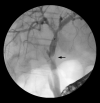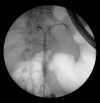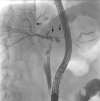Intensified Endoscopic Evaluation for Biliary Complications After Orthotopic Liver Transplantation
- PMID: 33820906
- PMCID: PMC8035812
- DOI: 10.12659/AOT.928907
Intensified Endoscopic Evaluation for Biliary Complications After Orthotopic Liver Transplantation
Abstract
BACKGROUND Biliary complications are common causes of morbidity and mortality after liver transplantation. MATERIAL AND METHODS From 2013 to 2018, 102 whole-organ liver transplantations were conducted in our department. Patients were closely monitored for biliary complication development. In all suspected cases, patients underwent either endoscopic retrograde cholangiopancreatography or percutaneous transhepatic cholangial drainage. Patients' demographic characteristics, preexisting conditions, and perioperative characteristics, as well as morbidity and mortality, were analyzed. Risk factors for 1-year survival were calculated. RESULTS Of the 102 patients, 43 (42%) experienced biliary complications. In comparison with patients without biliary complications, patients with biliary complications exhibited the following risk factors: underlying liver disease (viral hepatitis; P=0.009), blood group A (P=0.005), and previous abdominal surgery (P=0.037). Neither perioperative characteristics, especially duration of cold ischemia (P=0.86), nor postoperative course differed between patients with and without biliary complications. Risk factors for mortality within 1 year were cirrhosis caused by entities other than viral hepatitis (P=0.017), cardiac comorbidities (P=0.019), re-transplantation (P=0.032), and reduced organ weight (P=0.002). Biliary complications, postoperative hemorrhage, primary nonfunction, and repeated surgery worsened outcome; moreover, serum bilirubin trough in the first 30 days after transplantation might be prognostic for mortality (P=0.043). CONCLUSIONS Biliary complications adversely affect outcome after liver transplantation. Neither frequency nor outcome of biliary complications was improved by intensified endoscopic evaluation. Patients on the waiting list for liver transplants should also be closely monitored for cardiac comorbidities.
Conflict of interest statement
None.
Figures
Similar articles
-
Endoscopic management of postoperative biliary complications in orthotopic liver transplantation.Gastrointest Endosc. 2000 Jul;52(1):55-63. doi: 10.1067/mge.2000.106687. Gastrointest Endosc. 2000. PMID: 10882963
-
Percutaneous transhepatic cholangiography and drainage is an effective rescue therapy for biliary complications in liver transplant recipients who fail endoscopic retrograde cholangiopancreatography.J Chin Med Assoc. 2009 Aug;72(8):395-401. doi: 10.1016/S1726-4901(09)70395-8. J Chin Med Assoc. 2009. PMID: 19686994
-
Role of endoscopic retrograde cholangiopancreatography in the diagnosis and treatment of biliary tract complications after orthotopic liver transplantation.Dig Liver Dis. 2002 Aug;34(8):582-6. doi: 10.1016/s1590-8658(02)80092-5. Dig Liver Dis. 2002. PMID: 12502215
-
Biliary complications following liver transplantation.World J Gastroenterol. 2013 May 21;19(19):2841-6. doi: 10.3748/wjg.v19.i19.2841. World J Gastroenterol. 2013. PMID: 23704818 Free PMC article. Review.
-
Biliary complications of orthotopic liver transplantation.Dig Dis. 1999;17(3):133-44. doi: 10.1159/000016918. Dig Dis. 1999. PMID: 10697662 Review.
Cited by
-
Feasibility and Safety of ERCP in the Treatment of Biliary Strictures after Liver Transplantation: With a Report of 37 Cases.Gastroenterol Res Pract. 2022 Aug 23;2022:4498443. doi: 10.1155/2022/4498443. eCollection 2022. Gastroenterol Res Pract. 2022. PMID: 36052377 Free PMC article.
-
Obesity Does Not Influence Delayed Gastric Emptying Following Pancreatoduodenectomy.Biology (Basel). 2022 May 17;11(5):763. doi: 10.3390/biology11050763. Biology (Basel). 2022. PMID: 35625491 Free PMC article.
-
Biliary and Vascular Complications after Liver Transplantation-From Diagnosis to Treatment.Medicina (Kaunas). 2023 Apr 28;59(5):850. doi: 10.3390/medicina59050850. Medicina (Kaunas). 2023. PMID: 37241082 Free PMC article. Review.
References
-
- Merion RM, Schaubel DE, Dykstra DM, et al. The survival benefit of liver transplantation. Am J Transplant. 2005;5(2):307–13. - PubMed
-
- Charlton MR. Roadmap for improving patient and graft survival in the next 10 years. Liver Transpl. 2016;22(S1):71–78. - PubMed
-
- Verdonk RC, Buis CI, Porte RJ, et al. Anastomotic biliary strictures after liver transplantation: Causes and consequences. Liver Transpl. 2006;12(5):726–35. - PubMed
-
- Starzl TE, Putnam CW, Hansbrough JF, et al. Biliary complications after liver transplantation: With special reference to the biliary cast syndrome and techniques of secondary duct repair. Surgery. 1977;81(2):212–21. - PubMed
MeSH terms
LinkOut - more resources
Full Text Sources
Other Literature Sources
Medical




